 W
WAmeridelphia is traditionally a superorder that includes all marsupials living in the Americas except for the Monito del monte (Dromiciops). It is now regarded as a paraphyletic group.
 W
WAztlanolagus is an extinct monotypic genus of rabbit that lived during the Quaternary in what is now the Southern to Southwestern United States and northern Mexico. Aztlanolagus agilis is currently the only recognized species, though differences among recovered fossils suggest that there may have been other species. The generic name refers to Aztlán, the legendary place of origin of the Nahua peoples as recorded in the mythological accounts of the Aztecs and other Nahua groups. By some traditions, this legendary locale is placed in the border regions of the Southwestern United States and adjacent northern Mexico.
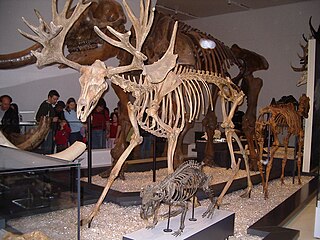 W
WCervalces is an extinct deer genus that lived during the Pliocene and Pleistocene epochs. Cervalces gallicus, the ancestral species, lived in Europe from the Pliocene to the Pleistocene strata. Cervalces scotti, the stag-moose, lived in Pleistocene North America. Cervalces latifrons, the broad-fronted moose, and Cervalces carnutorum were found in Pleistocene Europe and Asia.
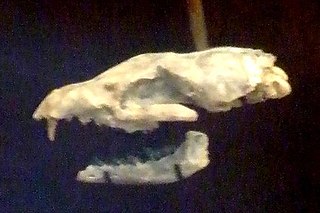 W
WCormocyon is an extinct genus of borophagine canid native to North America. It lived from the Oligocene to the Early Miocene, 30.8—20.6 Mya, existing for about 10.2 million years . It is regarded as a primitive, transitional member of the Borophagini tribe.
 W
WCynodesmus is an extinct genus of omnivorous canine which inhabited North America during the Oligocene living from 33.3—-26.3 Ma and existed for approximately 7 million years .
 W
WDusisiren is an extinct genus of dugong related to the Steller's sea cow that lived in the North Pacific during the Neogene.
 W
WGomphotherium is an extinct genus of proboscids from the Neogene and early Pleistocene of Eurasia, Africa, North America and possibly also Asia.
 W
WHipparion is an extinct genus of horse that lived in North America, Asia, Europe, and Africa during the Miocene through Pleistocene ~23 Mya—781,000 years ago. It lived in non-forested, grassy plains, shortgrass prairie or steppes.
 W
WHomotherium is an extinct genus of machairodontine saber-toothed cats, often termed scimitar-toothed cats, that inhabited North America, South America, Eurasia, and Africa during the Pliocene and Pleistocene epochs, existing for approximately 4 million years.
 W
WHyaenodon ("hyena-tooth") is the type genus of the Hyaenodontidae, a family of extinct carnivorous fossil mammals from Eurasia, North America, and Africa, with species existing temporally from the Eocene until the middle Miocene, existing for about 26.1 million years .
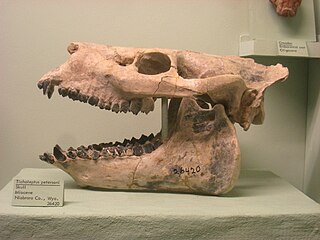 W
WHypsiops is an extinct genus of oreodont of the family Merycoidodontidae endemic to North America. They lived during the Late Oligocene to Early Miocene epochs, 20.4—16.0 mya, existing for approximately 4 million years . Fossils have been uncovered throughout the western U.S. in Oregon, Montana, Wyoming, and Nebraska.
 W
WThe genus Leptocyon includes 11 species and was the first canine. They were small and weighed around 2 kilograms (4.4 lb). They first appeared in North America around 34 million years ago in the Oligocene at the same time as the Borophaginae with whom they share features, indicating that these were two sister groups. Borophaginae skull and dentition were designed for a powerful killing bite compared with the Leptocyon which were designed for snatching small, fast-moving prey. The species L. delicatus is the smallest canid to have existed. At the close of their genus 9 million years ago one Leptocyon lineage resembled the modern fox.
 W
WA mammoth is any species of the extinct elephantid genus Mammuthus, one of the many genera that make up the order of trunked mammals called proboscideans. The various species of mammoth were commonly equipped with long, curved tusks and, in northern species, a covering of long hair. They lived from the Pliocene epoch into the Holocene at about 4,000 years ago, and various species existed in Africa, Europe, Asia, and North America. They were members of the family Elephantidae, which also contains the two genera of modern elephants and their ancestors.
 W
WMegantereon was a genus of prehistoric machairodontine saber-toothed cat that lived in North America, Eurasia, and Africa. It may have been the ancestor of Smilodon.
 W
WMetailurus is a genus of saber-toothed cat in the family Felidae, and belonging to the tribe Metailurini, which occurred in North America, Eurasia and Africa from the Miocene to the Middle Pleistocene. This genus was formally described by O. Zdansky in 1924. Metailurus minor has been reassigned to the felid genus Yoshi.
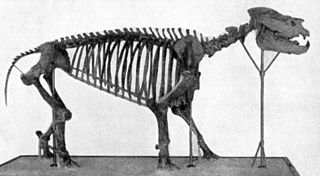 W
WMetamynodon is an extinct genus of amynodont rhino that lived in North America and Asia from the late Eocene until early Oligocene, although the questionable inclusion of M. mckinneyi could extend their range to the Middle Eocene. The various species were large, displaying a suit of semiaquatic adaptations similar to those of the modern hippopotamus despite their closer affinities with rhinoceroses.
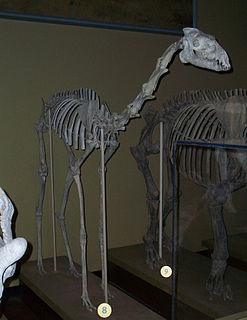 W
WOxydactylus is an extinct genus of camelid endemic to North America. It lived from the Late Oligocene to the Middle Miocene, existing for approximately 14 million years . The name is from the Ancient Greek οξύς and δάκτυλος.
 W
WParamys is an extinct genus of rodents from North America, Europe, and Asia. It is one of the oldest genera of rodents known and probably lived in trees. While the genus name literally means "like a mouse", it coexisted with Thisbemys, a similar rodent, thus yielding a reference to Pyramus and Thisbe.
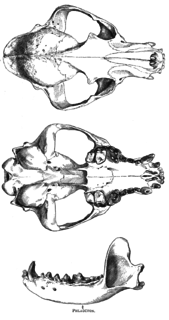 W
WPhlaocyon is an extinct genus of the Borophaginae subfamily of canids native to North America. It lives from the Early Oligocene to the Early Miocene epoch 33.3–16.3 Mya, existing for approximately 17.3 million years . It is closely related to Cynarctoides.
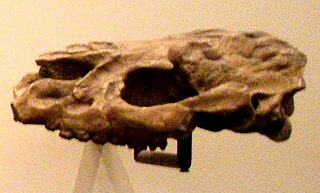 W
WProtapirus is an extinct genus of tapir. Fossil specimens of this genus have been found in North America and Europe.
 W
WStegomastodon is an extinct genus of gomphotheres, a family of proboscideans. It ranged throughout North America from the early Blancan ~4 Ma, to the early Irvingtonian. The South American species have been synonymized with Notiomastodon platensis.
 W
WTemnocyon is an extinct genus of bear-dogs endemic to North America. It lived from the Oligocene to Early Miocene approximately 30.8—20.4 mya, existing for about 11 million years .
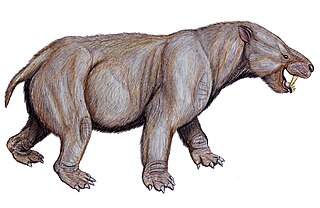 W
WTitanoides is an extinct genus of pantodont mammal that lived in North Dakota. They were up to 3 m (9.8 ft) long and up to 150 kg (330 lb) in weight, being the largest mammals of their habitat, a tropical swampland where the main predators were crocodiles. They had a bear-like appearance with huge canines, short limbs and five clawed digits; however, they were herbivores and probably had traits and attributes more similar to diprotodontids.